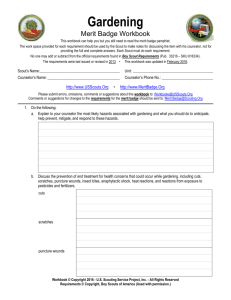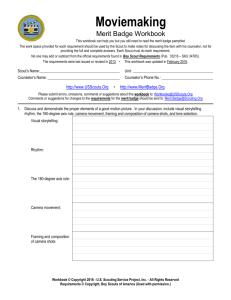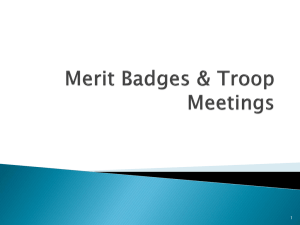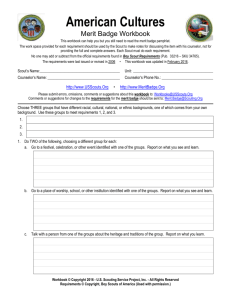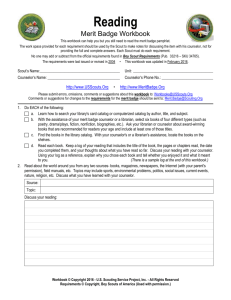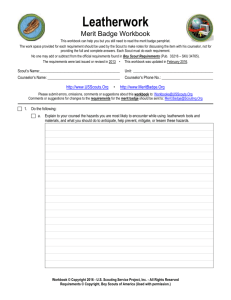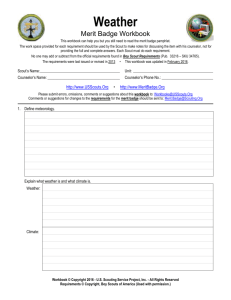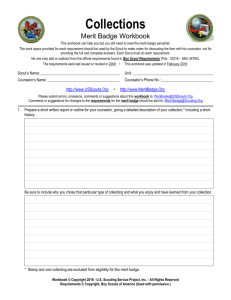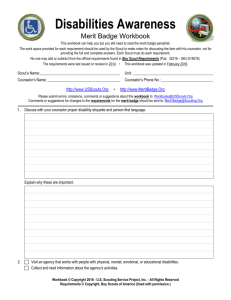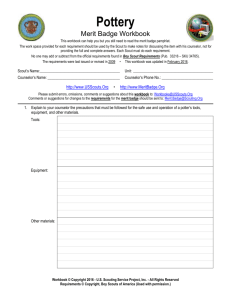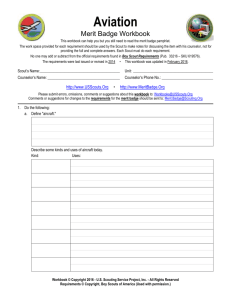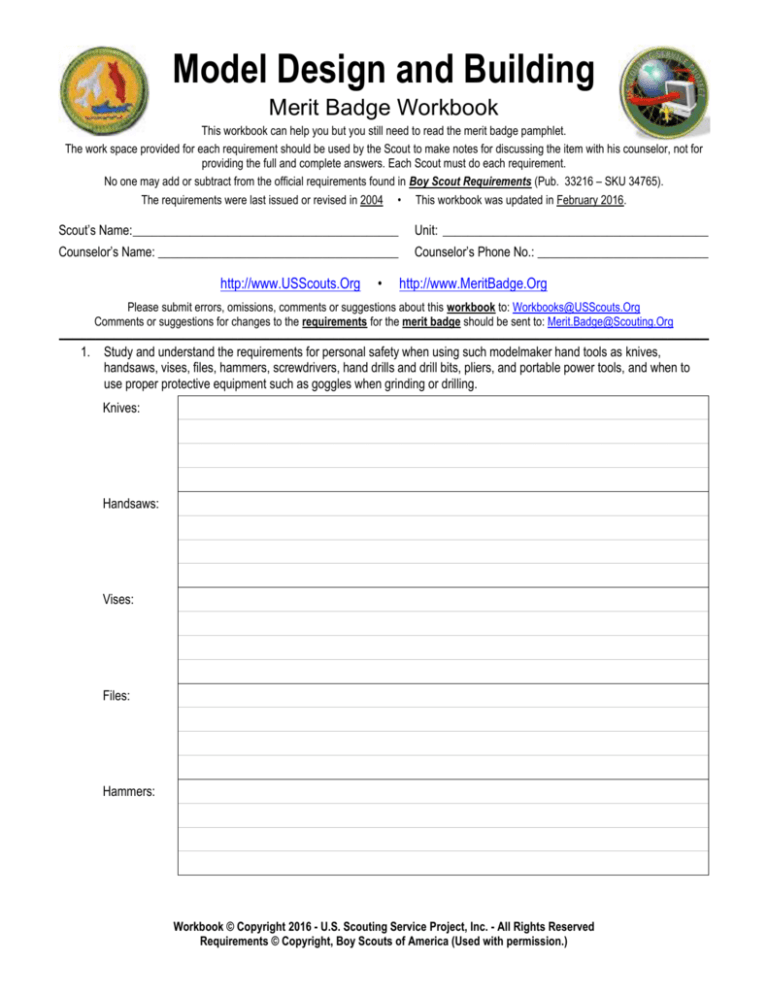
Model Design and Building
Merit Badge Workbook
This workbook can help you but you still need to read the merit badge pamphlet.
The work space provided for each requirement should be used by the Scout to make notes for discussing the item with his counselor, not for
providing the full and complete answers. Each Scout must do each requirement.
No one may add or subtract from the official requirements found in Boy Scout Requirements (Pub. 33216 – SKU 34765).
The requirements were last issued or revised in 2004 • This workbook was updated in February 2016.
Scout’s Name:__________________________________________
Unit: __________________________________________
Counselor’s Name: ______________________________________
Counselor’s Phone No.: ___________________________
http://www.USScouts.Org
•
http://www.MeritBadge.Org
Please submit errors, omissions, comments or suggestions about this workbook to: Workbooks@USScouts.Org
Comments or suggestions for changes to the requirements for the merit badge should be sent to: Merit.Badge@Scouting.Org
______________________________________________________________________________________________________________________________________________
1. Study and understand the requirements for personal safety when using such modelmaker hand tools as knives,
handsaws, vises, files, hammers, screwdrivers, hand drills and drill bits, pliers, and portable power tools, and when to
use proper protective equipment such as goggles when grinding or drilling.
Knives:
Handsaws:
Vises:
Files:
Hammers:
Workbook © Copyright 2016 - U.S. Scouting Service Project, Inc. - All Rights Reserved
Requirements © Copyright, Boy Scouts of America (Used with permission.)
Model Design and Building
Scout's Name: ________________________
Screwdrivers:
Hand drills
and drill bits:
Pliers,
Portable
power tools:
When to use proper protective equipment such as goggles when grinding or drilling:
Know what precautions to take when using flammable or hazardous products such as glue, epoxy, paint, and thinners.
Model Design and Building - Merit Badge Workbook
Page. 2 of 7
Model Design and Building
Scout's Name: ________________________
Discuss these with your counselor before you begin your modelmaking project and tell why they are important.
2. Explain the uses for each of the following types of models: architectural, structural, process, mechanical, and industrial.
Architectural:
Structural:
Process:
Mechanical:
Industrial:
Model Design and Building - Merit Badge Workbook
Page. 3 of 7
Model Design and Building
Scout's Name: ________________________
Do research into the different types of materials that could be used in making these models.
3. With your counselor's advice, select a subject from requirement 4 for your model project (no kits).
Subject: _________________________________________________________________________________________
Prepare the necessary plans to the proper scale.
Make a list of materials and a list of the required tools.
Materials:
Tools:
This model should be your own original work.
Tell why you selected this subject.
Model Design and Building - Merit Badge Workbook
Page. 4 of 7
Model Design and Building
Scout's Name: ________________________
4. Do ONE of the following:
a. Make an architectural model. Build a model of a house to a scale of ¼" = 10" (50:1 metric). Discuss with your
counselor the materials you intend to use, the amount of detail required, outside treatment (finish, shrubbery,
walks, etc.), and color selections. After completing the model, present it to your counselor for approval.
b. Build a structural model. Construct a model showing corner construction of a wood-frame building to a scale of
1 ½" = 10" (8:1 metric). All structures shown must be to scale. Cardboard or flat sheet wood stock may be
used for sheeting or flooring on the model. Review with your counselor the problems you encountered in
gathering the materials and supporting the structure. Be able to name the parts of the floor and wall frames,
such as intermediate girder, joist, bridging, subfloor, sill, sole plate, stud, and rafter.
c. Make a process model. Build a model showing the plumbing system in your house. Show hot and cold water
supply, all waste returns, and venting to a scale of ¾" = 10" (15:1 metric). Talk to your counselor about how to
begin this model, and present the scale and the materials you will use. After completion, present the model to
your counselor, and be prepared to discuss any problems you had building this model.
d. Complete a mechanical model. Build a model of a mechanical device that uses at least two of the six simple
machines. After completing the model, present it to your counselor. Be prepared to discuss materials used, the
machine's function, and any particular difficulty you might have encountered.
e. Make an industrial model. Build a model of an actual passenger-carrying vehicle to a scale of 1" = 10" or ½" =
10" (10:1 or 25:1 metric). Take the dimensions of the vehicle and record the important dimensions. Draw the
top, front, rear, and sides of the vehicle to scale. From your plans, build a model of the vehicle and finish it in a
craftsmanlike manner. Discuss with your counselor the most difficult part of completing the model.
5. Build a special-effects model of a fantasy spacecraft that might appear in a Hollywood science-fiction movie. Determine
an appropriate scale for your design - one that makes practical sense. Include a cockpit or control area, living space,
storage unit, engineering spaces, and propulsion systems. As you plan and build your model, do the following:
a. Study aircraft, submarines, and naval ships for design ideas.
b. Arrange and assemble the parts.
c. Sketch your completed model.
d. Write a short essay in which you discuss your design, scale, and materials choices. Describe how you
engineered your model and discuss any difficulties you encountered and what you learned.
(Use a separate sheet of paper for the essay.)
Model Design and Building - Merit Badge Workbook
Page. 5 of 7
Model Design and Building
Scout's Name: ________________________
6. List at least six occupations in which modelmaking is used and discuss with your counselor some career opportunities in
this field.
Occupation
Career Opportunities
1.
2.
3.
4.
5.
6.
Requirement resources can be found here:
http://www.meritbadge.org/wiki/index.php/Model Design and Building#Requirement resources
Model Design and Building - Merit Badge Workbook
Page. 6 of 7
Important excerpts from the Guide To Advancement - 2013, No. 33088 (SKU-618673)
[1.0.0.0] — Introduction
The current edition of the Guide to Advancement is the official source for administering advancement in all Boy Scouts of America programs: Cub
Scouting, Boy Scouting, Varsity Scouting, Venturing, and Sea Scouts. It replaces any previous BSA advancement manuals, including Advancement
Committee Policies and Procedures, Advancement and Recognition Policies and Procedures, and previous editions of the Guide to Advancement.
[Page 2, and 5.0.1.4] — Policy on Unauthorized Changes to Advancement Program
No council, committee, district, unit, or individual has the authority to add to, or subtract from, advancement requirements. There are limited
exceptions relating only to youth members with special needs. For details see section 10, “Advancement for Members With Special Needs”.
[Page 2] — The “Guide to Safe Scouting” Applies
Policies and procedures outlined in the Guide to Safe Scouting, No. 34416, apply to all BSA activities, including those related to advancement and
Eagle Scout service projects.
[7.0.3.1] — The Buddy System and Certifying Completion
A youth member must not meet one-on-one with an adult. Sessions with counselors must take place where others can view the interaction, or the
Scout must have a buddy: a friend, parent, guardian, brother, sister, or other relative—or better yet, another Scout working on the same badge—along
with him attending the session.
When the Scout meets with the counselor, he should bring any required projects. If these cannot be transported, he should present evidence, such as
photographs or adult verification. His unit leader, for example, might state that a satisfactory bridge or tower has been built for the Pioneering merit
badge, or that meals were prepared for Cooking. If there are questions that requirements were met, a counselor may confirm with adults involved.
Once satisfied, the counselor signs the blue card using the date upon which the Scout completed the requirements, or in the case of partials, initials
the individual requirements passed.
Note that from time to time, it may be appropriate for a requirement that has been met for one badge to also count for another. See “Fulfilling More
Than One Requirement With a Single Activity,” 4.2.3.6.
[7.0.3.2] — Group Instruction
It is acceptable—and sometimes desirable—for merit badges to be taught in group settings. This often occurs at camp and merit badge midways or
similar events. Interactive group discussions can support learning. The method can also be attractive to “guest experts” assisting registered and
approved counselors. Slide shows, skits, demonstrations, panels, and various other techniques can also be employed, but as any teacher can attest,
not everyone will learn all the material.
There must be attention to each individual’s projects and his fulfillment of all requirements. We must know that every Scout —actually and
personally— completed them. If, for example, a requirement uses words like “show,” “demonstrate,” or “discuss,” then every Scout must do that. It is
unacceptable to award badges on the basis of sitting in classrooms watching demonstrations, or remaining silent during discussions.
It is sometimes reported that Scouts who have received merit badges through group instructional settings have not fulfilled all the requirements. To
offer a quality merit badge program, council and district advancement committees should ensure the following are in place for all group instructional
events.
Merit badge counselors are known to be registered and approved.
Any guest experts or guest speakers, or others assisting who are not registered and approved as merit badge counselors, do not accept the
responsibilities of, or behave as, merit badge counselors, either at a group instructional event or at any other time. Their service is temporary, not
ongoing.
Counselors agree not to assume prerequisites have been completed without some level of evidence that the work has been done. Pictures and
letters from other merit badge counselors or unit leaders are the best form of prerequisite documentation when the actual work done cannot be
brought to the camp or site of the merit badge event.
There is a mechanism for unit leaders or others to report concerns to a council advancement committee on summer camp merit badge programs,
group instructional events, and any other merit badge counseling issues—especially in instances where it is believed BSA procedures are not
followed. See “Reporting Merit Badge Counseling Concerns,” 11.1.0.0.
There must be attention to each individual’s projects and his fulfillment of all requirements. We must know that every Scout—actually and
personally—completed them.
[7.0.3.3] — Partial Completions
A Scout need not pass all the requirements of one merit badge with the same counselor. It may be that due to timing or location issues, etc., he must
meet with a different counselor to finish the badge. The Application for Merit Badge has a place to record what has been finished—a “partial.” In the
center section on the reverse of the blue card, the counselor initials for each requirement passed. In the case of a partial completion, the counselor
does not retain his or her portion of the card. A subsequent counselor may choose not to accept partial work, but this should be rare. A Scout, if he
believes he is being treated unfairly, may work with his unit leader to find another counselor. An example for the use of a signed partial would be to
take it to camp as proof of prerequisites. Partials have no expiration except the Scout’s 18th birthday. Units, districts, or councils shall not establish
other expiration dates for partial merit badges.
[7.0.4.8] — Unofficial Worksheets and Learning Aids
Worksheets and other materials that may be of assistance in earning merit badges are available from a variety of places including unofficial sources
on the Internet and even troop libraries. Use of these aids is permissible as long as the materials can be correlated with the current requirements that
Scouts must fulfill. Completing “worksheets” may suffice where a requirement calls for something in writing, but this would not work for a requirement
where the Scout must discuss, tell, show, or demonstrate, etc. Note that Scouts shall not be required to use these learning aids in order to complete a
merit badge.
Attachment
(NOTE: It is not necessary to print this page.)
Page 7 of 7


